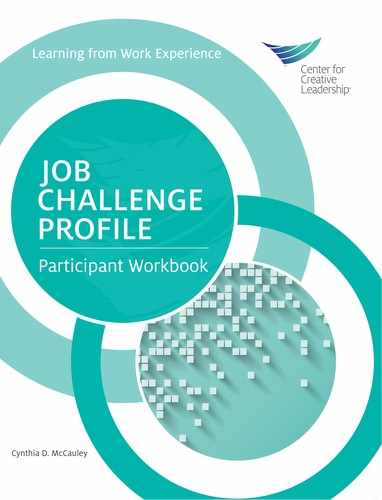Scoring the
Job Challenge Profile
DIRECTIONS: After answering all the items on the Job Challenge Profile, use the scoring grid on the following page to calculate your scores for the ten developmental job components. To do this, first transfer your ratings for each item to the appropriate line on the grid. Note that items are not in numerical order. Add the five ratings in each section to obtain your score on each component, which can range from 5 to 25. The higher your score, the more descriptive that job component is of your job. We refer to these scores as your actual job component scores.
Your Relative Scores
Another important set of scores is your relative job component scores. Your relative scores show how the developmental components in your job compare to those experienced by other managers in our database. They show whether your scores are low, high, or about average relative to how other managers have rated their jobs. A high score indicates that you report considerably more of that component in your job than do other managers, and a low score indicates that you have considerably less of that component in your job than other managers in the database. Use the chart on page 11 to graph your relative job component scores by (1) transferring your actual scores from your Scoring Sheet to the boxes and (2) putting an “X” on each column to indicate where your score falls in comparison with others who have taken the inventory.
*lf your exact score is not shown, simply mark your score in the appropriate category (high, moderate, or low).
Your Pattern of Relative Scores
Before examining the various job components individually, let’s look at your relative scores. First, decide which of the following patterns fits your results:
A. For the most part, high relative to how others have rated their jobs.
B. For the most part, moderate relative to how others have rated their jobs.
C. For the most part, low relative to how others have rated their jobs.
D. A mixture of low, moderate, and high.
Now read the appropriate description of your job below.
A. Your job is full of potential challenge. Most people who have high scores across the board say that their jobs are often too much of a stretch. Feeling too stressed can actually interfere with learning. If this describes your job, you may want to find ways to decrease the challenge in some areas so that you can focus more of your energy on the challenges in other areas. If you consider your situation to be temporary, due to unusual circumstances that will change in the near future, then you may choose to take no action at this time. However, be aware that you will not be as effective as you could be, so be sure to check your job challenge again in a few months.
B. Your job has more or less the same amount of the components as the average managerial job. The degree of challenge you experience in your job from any of these components depends on whether you have successfully dealt with them in previous jobs. Components you have not been exposed to in previous jobs offer more opportunities for current learning.
C. Your job does not have as much of the components that tend to challenge and stretch managers as other managerial jobs do. This is often the pattern for entry-level managerial positions. Being in the lower range does not mean that you cannot learn from your job. For entry-level managers, such a job can still be a stretch. However, if you are an experienced manager, and all your scores are low, your job is likely not contributing to your continued growth.
D. This is the most common pattern, and actually the pattern that can bring the most potential for learning and growth. The moderate-to-high components offer opportunities for challenge and growth and the low-to-moderate components can be easily managed, resulting in a good mixture of stretching oneself and mastery of the job.


